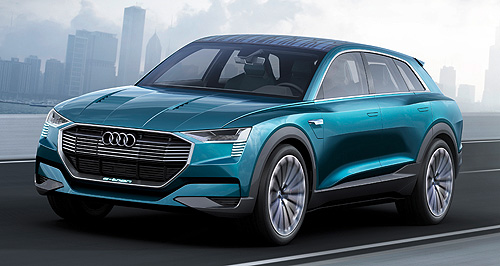Make / Model Search
News - AudiAudi maps autonomous plans, driver-less taxi by 2021Autobahn: Audi’s current autonomous driving system can handle straight divided freeways up to 60km/h, but future systems will likely handle higher speeds in more varied situations. Level four Audi driverless cars for 2021 launch, but level five still further away14 Jul 2017 By DANIEL DeGASPERI in BARCELONA AUDI has revealed it will move to level four driverless technology by 2021, with robot-taxis currently in development as a first step towards steering wheel-less level five capability. With the new-generation A8, Audi has moved from level two – or what it called ‘partial automation’ – to level three autonomous driving, also known as ‘conditional automation’, that makes it the first to allow the driver to do something else within the car in certain circumstances with speed, road and weather caveats. Audi described level four as ‘high automation’ that would still require a steering wheel and pedals but with less regular driver attention, and the step up to level five permits the driver to be contactless with controls in all situations. While Audi AG head of development for automated driving Alejandro Vukotich is confident level four autonomous technology will come to market in the next four years, he could not place a timeframe on when to expect level five. “The next step of bringing more level three and even level four systems (to market) will be occur around 2021,” he told GoAuto at the international reveal of the Audi A8 in Barcelona, Spain, this week. “We have already finished with the level five definition – it’s a car that can deal with every situation, and that means the driver is no longer needed, with no steering wheel. “That will take time.” Asked when Audi has targeted a production vehicle launch featuring level five autonomous technology, Mr Vukotich replied: “To be honest, I’m not sure, I think that it’s more about having direction.” More critically, given Audi has unveiled its latest A8 with level three driverless technology that is not yet legal anywhere in the world, the head of autonomous driving admitted that “not everywhere” will have legislation that keeps up with the roll-out of level four and level five technology. Asked whether there was now a greater challenge in dealing with government law-makers than developing autonomous technology itself, Mr Vukotich said: “I’d say that it’s 50:50. “You have to validate the systems and convince the authorities that it’s safe, that it follows their rules, what you’re putting in the car in terms of sensors, the driver of the car, is he going to use the car or watch movies, or whatever,” he said. “We’re lobbying in the major countries – the US, Europe and also having discussions in China – which are on different levels to others. Some parts are more advanced than others.” Mr Vukotich revealed that Audi had mapped a halfway point before selling production-model level four and five autonomous vehicles to customers, in the form of a city-based taxi currently in planning inside Ingolstadt headquarters. “We are working on that,” he said of a driverless taxi program. “There is a company in Munich that we are developing it with. Financially, for a robot taxi, it makes sense because it does without the need for a driver, but if it’s your car, you have to toss up whether it makes financial sense or not. “It’s (also) always a question of whether you want to own a car or use a car. A robot taxi doesn’t need to be perfectly designed, whereas if you own the car, you want it to look perfect because it’s yours.” The clear indication is that level five autonomous driving will require a substantial number of radars and sensors, potentially on the roof of the vehicle, that may not be cost effective or visually appealing for owners of Audi models. A so-called robot-taxi would also be confined to particular parts of a city, Mr Vukotich suggested, an obstacle which owners of a driverless car would likely find restrictive. Meanwhile, the A8 has launched with new zFAS electrical architecture, incorporating a “supercomputer” and backup computer to ensure the Audi AI – or autonomous intelligence – system working with the mooted Traffic Jam Pilot function does not fail. Audi has said that, when approved for road use, the system would take insurance responsibility if the vehicle was driving occupants autonomously. However, although the A8 debuts a world-first laser scanner in its front bumper along with further sensors and radars for the technology, Mr Vukotich made it clear that the step from the Audi upper-large sedan’s level three system to level four would require even more hardware. The A8’s level three technology is limited to sub-60km/h autonomous driving on straight divided freeways only, and it cannot change lanes. “The A8 is capable up to 60km/h or level three,” he continued. “If we increase the speed, and therefore increase the car’s rating to level four, there will be hardware to go into the car to make it possible. If you drive at higher speeds with no car ahead of you, the safe-state during an emergency would be to change lanes and stop on the shoulder. “That means there is significantly more for the car to think about – is there a shoulder on this motorway, is there not.” Audi will next launch its all-electric E-tron large SUV next year, followed by a coupe-style Sportback version in 2019 – both of which have been confirmed to utilise technology from the new A8 upper-large sedan (see separate story).  Read more13th of July 2017  Audi defends autonomous A8 announcementLead times meant Audi A8 autonomous tech had to be ready, even if laws were not12th of July 2017  Audi A8 debuts autonomous tech, but not for AusTech-fest A8 throws gauntlet down to rivals as glimpse of Audi future |
Click to shareAudi articlesResearch Audi Motor industry news |











Facebook Twitter Instagram